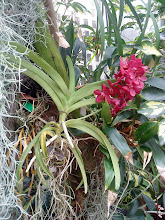
A few sunny spells are enough to bring spring to mind. I've started looking forward to seeing a few places that will come into their own before long: Gatton Park for snowdrops, Eltham Palace for its moat planted with spring flowers (as recommended by John Watkins, Head of Gardens and Landscapes at English Heritage) and Ightham Mote for bluebells.
This January has been darker than usual: since our unusual weather last year, I've become more interested in weather forecasts, and so far this month quite a few reports have remarked on dark skies in the mornings. There seems to have been a lot more cloud this year. In the first week of the year, at 7 it still felt like the middle of the night. Nature writer Paul Evans recently summed it up: 'January looked glum'.
But the god of January, Janus, looks forward as well as back, and those sunny spells point the way forward. I first came across Janus, the two-headed gateway god, in a medieval book on agriculture: each chapter began with a beautiful woodcut of a month. What impressed me about the woodcuts for the winter months was that there seemed to be more of an acceptance of the dark times of the years, an appreciation of the seasons. Janus had a particular vitality - the worst was over and a new year promised new opportunities.
As the gateway god, Janus might seem like a wintry god yet he holds the key to the future. The god in the above Roman image now used on an Australian coin, strikes me as steely and determined, rather than glum. In his prime, you could say. It's no accident that he sports a luxuriant beard since the first month of the year is traditionally associated with age (as with January, the old knight in Chaucer's The Merchant's Tale, although, admittedly, the story mocks foolish old age). On a less serious note, these days, post-Christmas, there's less heed paid to clean-shaven looks (less maintenance seems required in general, which comes as something of a relief to many).
A fortnight ago, I went to Gatton Park, in Surrey, where I heard that a return visit would be worthwhile for the snowdrops. I was there for a meeting of the Orchid Society of Great Britain; Gatton Park last belonged to Sir Jeremiah Colman, of Colman's Mustard fame, who was one of the country's first orchid growers. He started to hybridise plants in 1900; by 1905, he had twelve glasshouses, where thousands were hybridised.


Sir Jeremiah was a kind of orchid ambassador; he spread the word about orchid growing by sending plants around the world to encourage people. One plant sent to Honolulu was used in a beauty queen's crown.
The grounds of Gatton Park were laid out by Capability Brown - they had that indef
 inably dreamy look of a classic Brown landscape. A midnight blue lake in a haze surrounded by trees, viewed from a plateau of perfect lawn sloping down to it.
inably dreamy look of a classic Brown landscape. A midnight blue lake in a haze surrounded by trees, viewed from a plateau of perfect lawn sloping down to it.Gatton Park is part-managed by the National Trust and looked after entirely by volunteers. Recent initiatives include restoring vistas by removing trees. Wildlife is encouraged in every way: I heard that there were twenty-five pairs of herons - a major feature of Gatton Park, the original heronry on the lake was known as "the grand water menagerie". Other attractions include a Japanese garden recreated as part of Channel 4's Hidden Gardens series and a rock garden, where you'll find the snowdrops.
There was a fabulous display of orchids grown by m
 embers of OSGB in one of the greenhouses. Orchid names can be as colourful as the plants themselves, like the irr
embers of OSGB in one of the greenhouses. Orchid names can be as colourful as the plants themselves, like the irr esistible Paph Red Glory x Voodoo Magic (left).
esistible Paph Red Glory x Voodoo Magic (left).
These hothouse flowers also come into their own in the springtime, with forthcoming annual shows: the London Orchid Show, in March, and the RHS Chelsea Flower Show, in May.
- Gatton Park is open to the public on the first Sunday of each month, 1pm - 5pm (www.gattonpark.com).
